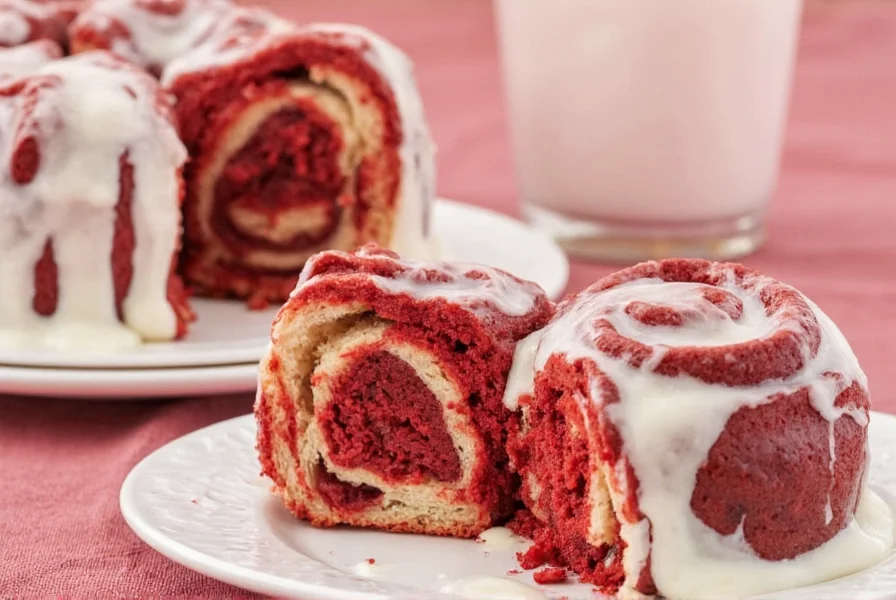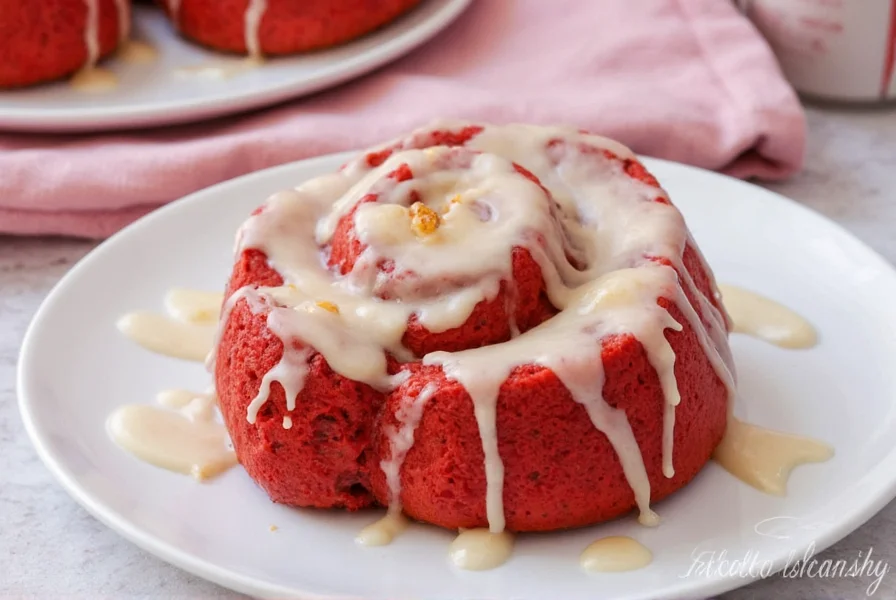These decadent pastries feature a soft, enriched dough swirled with cinnamon-sugar and cocoa, then topped with a rich cream cheese frosting. The red color traditionally comes from food coloring, though some modern variations use beet juice for natural coloring. Properly made red velvet cinnamon rolls should have a tender crumb, balanced sweetness, and that signature red velvet flavor profile that's neither overwhelmingly chocolate nor artificially sweet.
The Unique Appeal of Red Velvet Cinnamon Rolls
Red velvet cinnamon rolls represent a creative fusion of two beloved American baked goods. Unlike traditional cinnamon rolls that focus primarily on cinnamon-sugar filling, red velvet versions incorporate cocoa powder and buttermilk into the dough, creating a more complex flavor profile. The buttermilk provides subtle tanginess that balances the sweetness, while the cocoa adds depth without making the rolls taste like chocolate.
What sets the best red velvet cinnamon rolls recipe apart is the careful balance of ingredients. Too much food coloring creates an artificial taste, while insufficient cocoa fails to deliver the distinctive red velvet character. The ideal ratio creates a pastry that's visually impressive without compromising on flavor.

Essential Ingredients Breakdown
Creating authentic red velvet cinnamon rolls requires understanding each component's role:
| Ingredient | Function | Substitution Options |
|---|---|---|
| Buttermilk | Provides tanginess that balances sweetness and activates baking soda | Milk + 1 tbsp vinegar (let sit 5 minutes) |
| Cocoa powder | Creates red velvet flavor base without overpowering chocolate taste | None (wouldn't be authentic red velvet) |
| Red food coloring | Creates signature color (traditional recipes use 1-2 oz) | Beet powder or juice for natural coloring |
| Cream cheese | Essential for authentic frosting tanginess and texture | Full-fat block cream cheese only (not spreadable) |
Step-by-Step Preparation Guide
Follow these professional techniques when preparing your red velvet cinnamon rolls from scratch:
- Dough preparation: Warm buttermilk to 110°F (43°C), then combine with yeast and 1 tablespoon sugar. Let sit for 5-10 minutes until foamy. In stand mixer, combine flour, cocoa powder, salt, and remaining sugar. Add yeast mixture, eggs, and softened butter. Mix until smooth dough forms (about 8 minutes).
- First rise: Place dough in greased bowl, cover with damp cloth, and let rise in warm place until doubled (1-1.5 hours). Properly risen dough should spring back slowly when gently pressed.
- Filling application: Roll dough into 18x12 inch rectangle. Spread softened butter evenly, then sprinkle cinnamon-sugar mixture (1 cup brown sugar, 2 tbsp cinnamon, 2 tbsp cocoa). Avoid overfilling edges to prevent leakage during baking.
- Rolling technique: Starting from long edge, roll tightly into log. Pinch seam to seal. Use unflavored dental floss to slice into 1.5-inch pieces for clean cuts without squishing.
- Baking process: Place rolls in greased 9x13 inch pan with space between them. Let rise 30 minutes. Bake at 350°F (175°C) for 22-25 minutes until golden brown. Red velvet cinnamon rolls baking time varies based on pan size and oven accuracy.
Common Mistakes to Avoid
Even experienced bakers encounter issues with red velvet cinnamon rolls troubleshooting. Here are solutions to frequent problems:
- Pale color: Traditional red velvet requires substantial food coloring (1-2 oz liquid coloring). Natural alternatives like beet juice create a more subtle pink hue.
- Dense texture: Over-kneading or too much flour creates tough rolls. Measure flour properly by spooning into measuring cup and leveling.
- Filling leakage: Leave ½ inch border when applying filling and ensure tight rolling technique to contain the filling.
- Flat rolls: Over-proofing causes rolls to spread rather than rise. Second rise should be just 30 minutes before baking.
Serving and Storage Recommendations
For optimal enjoyment of your red velvet cinnamon rolls with cream cheese frosting, follow these professional tips:
- Apply frosting while rolls are still warm (not hot) to allow it to melt slightly into the crevices
- Serve within 2 hours of baking for best texture and flavor
- Store leftovers in airtight container at room temperature for up to 2 days
- Reheat individual rolls in microwave for 15 seconds before serving
- Freeze unbaked rolls for up to 3 months—thaw overnight in refrigerator before baking
Frequently Asked Questions
Can I make red velvet cinnamon rolls without food coloring?
Yes, you can create naturally colored red velvet cinnamon rolls using alternatives like beet powder or beet juice. Replace ¼ cup of the buttermilk with an equal amount of beet juice for a subtle pink hue. Note that the color will be less vibrant than traditional recipes using food coloring, and the flavor will have a slight earthiness from the beets. The cocoa content remains essential for authentic red velvet flavor.
Why did my red velvet cinnamon rolls turn out dry?
Dry red velvet cinnamon rolls typically result from overbaking, excessive flour, or insufficient fat content. Measure flour properly using the spoon-and-level method rather than scooping directly. Ensure your oven temperature is accurate with an oven thermometer, as even 25°F variance affects moisture. The buttermilk and butter content must remain balanced—reducing fat for "healthier" versions often compromises texture. Properly baked rolls should register 190°F internally.
What's the difference between red velvet and chocolate cinnamon rolls?
Red velvet cinnamon rolls contain significantly less cocoa than chocolate versions, creating a subtle chocolate undertone rather than dominant chocolate flavor. The buttermilk and vinegar components provide distinctive tanginess absent in chocolate rolls. Traditional red velvet uses red food coloring for visual appeal, while chocolate rolls rely on cocoa's natural color. The flavor profile balances vanilla, cocoa, and acidity, whereas chocolate rolls emphasize chocolate intensity.
How do I prevent my red velvet cinnamon rolls from becoming too red?
To achieve the perfect red velvet color without artificial intensity, start with 1 tablespoon of liquid red food coloring and adjust as needed. Many professional bakers prefer gel coloring for more concentrated color with less liquid. Remember that the color deepens slightly during baking. For a more natural approach, use 2-3 tablespoons of beet powder mixed with your dry ingredients. The ideal red velvet should have a rich burgundy hue, not a bright artificial red.











 浙公网安备
33010002000092号
浙公网安备
33010002000092号 浙B2-20120091-4
浙B2-20120091-4